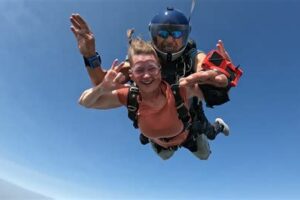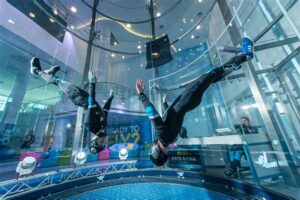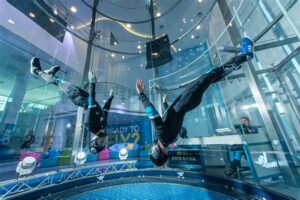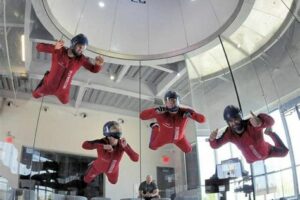Table of Contents
Ifly Vs Skydiving – a comparison between indoor skydiving and traditional outdoor skydiving experiences. Discover the differences in adrenaline rush, safety measures, and overall experience. Find out which one suits your adventure-seeking spirit and enjoy the thrill of defying gravity.
Are you ready to experience the thrill of defying gravity and soaring through the sky? Look no further than the exhilarating world of extreme sports. And when it comes to heart-pounding adventures, two activities often stand out: iFly and skydiving. Both offer a unique opportunity to feel the rush of adrenaline as you take the leap, but how do they differ? Let’s delve into the exciting realm of iFly and skydiving to explore what sets them apart and help you decide which one is right for you.
Introduction
When it comes to experiencing the thrill of flight, two popular options come to mind: iFly indoor skydiving and traditional skydiving. Both activities offer unique experiences that cater to different preferences and comfort levels. In this article, we will explore the differences between iFly and skydiving, helping you make an informed choice about which adventure suits you best.
iFly – The Indoor Skydiving Experience
1. What is iFly?
iFly is an indoor skydiving experience that simulates the feeling of freefall without the need for an airplane or parachute. Participants enter a vertical wind tunnel, where powerful fans generate enough wind to support the body in mid-air. This controlled environment provides a safe and controlled experience for all ages.
2. Accessibility and Safety
iFly is a great option for those seeking a taste of skydiving without the associated risks. It is accessible to people of various fitness levels and does not require any prior experience or training. Specially trained instructors guide participants throughout the entire process, ensuring their safety and enjoyment.
3. Learning and Skill Development
Besides the sheer thrill, iFly also offers an opportunity to learn and develop skills related to body control and balance. Instructors can provide personalized coaching, allowing participants to improve their techniques and progress in their flying abilities over time.
Skydiving – The Ultimate Adrenaline Rush
4. The Traditional Skydiving Experience
Skydiving involves jumping out of a plane at a high altitude, experiencing a thrilling freefall, and then safely landing on the ground with a parachute. It is an adventure that attracts adrenaline junkies seeking an unparalleled rush and an unforgettable experience.
5. Adrenaline and Sensory Experience
Skydiving offers an unmatched sensory experience as you feel the wind rushing past you, see the breathtaking views from above, and hear the exhilarating sounds of the environment. The adrenaline rush during the freefall is often described as an indescribable feeling of freedom and excitement.
6. Training and Certification
Unlike iFly, skydiving requires a certain level of training and certification. Aspiring skydivers must complete a comprehensive training program to ensure they understand the safety procedures, equipment usage, and proper skydiving techniques. This training instills confidence and prepares individuals for solo jumps.
Comparing the Experiences
7. Environment and Surroundings
iFly offers a controlled, indoor environment with consistent wind speeds, while skydiving allows you to experience the vastness of the open sky and take in breathtaking aerial views. The choice between the two experiences often depends on whether you prefer an enclosed setting or the thrill of being in the open air.
8. Cost and Accessibility
iFly is generally more accessible and affordable compared to skydiving. While skydiving requires booking a plane, professional instructors, and specialized equipment, iFly provides a budget-friendly alternative for those looking to experience the sensation of freefall without breaking the bank.
9. Safety and Risk
Both iFly and skydiving prioritize safety, but they come with different levels of risk. iFly eliminates the risks associated with jumping out of a plane, making it a safer option for individuals who may have physical limitations or fear of heights. Skydiving, on the other hand, involves higher inherent risks due to the nature of the activity.
10. Personal Preference and Thrill Level
Ultimately, the choice between iFly and skydiving comes down to personal preference and desired thrill level. If you seek a controlled yet exhilarating experience that is suitable for all ages and skill levels, iFly is an excellent choice. However, if you crave the ultimate adrenaline rush and want to push your limits, skydiving offers an unmatched adventure.
Conclusion
Whether you choose iFly or skydiving, both experiences offer unique thrills and opportunities for personal growth. iFly provides a safe and controlled environment for those looking to experience the sensation of flight, while skydiving offers the ultimate rush and an incredible sense of freedom. Consider your comfort level, budget, and desired level of adventure when deciding between these two exhilarating activities.
iFLY Vs Skydiving: A Comparative Analysis
Introduction:
When it comes to experiencing the thrill of flying without the need for an aircraft, both iFLY indoor skydiving and traditional skydiving offer unique opportunities. However, there are distinct differences between the two options that cater to different preferences and individual comfort levels. This article delves into eight subheadings outlining the variations between iFLY and skydiving.
1. Safety Measures:
While skydiving carries inherent risks, iFLY provides a controlled environment ensuring enhanced safety. State-of-the-art wind tunnels, certified instructors, and comprehensive training minimize the chances of accidents, making iFLY an attractive choice for those seeking a safer alternative.
2. Accessibility and Convenience:
Unlike skydiving, which generally requires traveling to specific drop zones and being dependent on weather conditions, iFLY centers are easily accessible in urban areas. With fixed operating hours, booking flexibility, and no weather-related setbacks, iFLY offers convenience that skydiving enthusiasts may appreciate.
3. Realism and Authenticity:
For thrill-seekers craving an authentic skydiving experience, traditional skydiving offers unparalleled realism. The adrenaline rush provided by jumping from an actual aircraft, free-falling in the open sky, and experiencing the breathtaking views cannot be replicated by indoor skydiving at iFLY.
4. Cost Considerations:
Budget plays a significant role when choosing between iFLY and skydiving. While skydiving is generally more expensive due to aircraft and equipment costs, iFLY sessions are comparatively affordable. Those seeking a more cost-effective option without compromising the thrill may find iFLY to be an ideal choice.
5. Physical Demands:
Skydiving requires a certain level of physical fitness, as it involves jumping, controlling the body during freefall, and landing safely. In comparison, iFLY imposes fewer physical demands, making it suitable for a wider range of individuals, including those with physical limitations or disabilities.
6. Time Commitment:
For those with time constraints, iFLY offers shorter sessions that still provide the exhilaration of flight. Skydiving, on the other hand, requires a more substantial time commitment as it involves traveling to the drop zone, attending briefings, and waiting for suitable weather conditions.
7. Group Participation:
When it comes to group activities or team-building events, iFLY offers a more feasible option. With multiple tunnels available, participants can fly simultaneously, enabling shared experiences. Skydiving, due to logistical limitations, may be more challenging to organize for a large group.
8. Personal Growth and Achievement:
Skydiving often presents an opportunity for personal growth, as individuals conquer fears, build confidence, and experience self-empowerment. The element of danger and pushing one’s limits can lead to a unique sense of achievement, making skydiving an appealing choice for those seeking personal development.
Conclusion:
The decision between iFLY and skydiving ultimately depends on individual preferences, considerations, and desired experiences. While iFLY provides a controlled environment, ease of access, and affordability, skydiving offers authenticity, physical challenges, and personal growth opportunities that cannot be replicated indoors. Understanding these differences allows individuals to make an informed choice and enjoy the thrill of flight in a manner that aligns with their goals and comfort levels.
Point of View: iFly vs. Skydiving
When it comes to experiencing the thrill of flight, two popular options often come to mind: iFly and skydiving. Both activities offer a unique opportunity to defy gravity and experience the sensation of flying. However, there are several factors to consider when choosing between these two options. In this analysis, we will compare iFly and skydiving from a professional perspective.
- Safety:
- iFly: One of the key advantages of iFly is its impeccable safety record. As an indoor skydiving facility, iFly eliminates many of the risks associated with traditional skydiving, such as parachute malfunctions and adverse weather conditions. The controlled environment ensures maximum safety for participants.
- Skydiving: While skydiving is inherently riskier than iFly, it is important to note that the sport has significantly improved its safety standards over the years. With modern equipment, rigorous training programs, and strict safety protocols, skydiving has become a relatively safe activity. However, it is crucial to choose a reputable skydiving center and follow all instructions to mitigate any potential risks.
- Realism:
- iFly: Although iFly provides a realistic simulation of skydiving, it is important to acknowledge that it lacks the authenticity of jumping out of an actual airplane. The wind tunnel experience at iFly replicates the feeling of freefall, but it cannot fully capture the breathtaking scenery and adrenaline rush that skydiving offers.
- Skydiving: Skydiving provides an unparalleled sense of realism and immersion. The breathtaking views from thousands of feet above the ground, the rush of wind against your face, and the adrenaline coursing through your veins make the experience truly unforgettable. Skydiving allows you to fully embrace the thrill of human flight in its purest form.
- Accessibility:
- iFly: iFly is accessible to a wider range of individuals as it does not require any prior experience or physical fitness. Almost anyone can participate in indoor skydiving, including children, elderly individuals, and those with certain physical limitations. The controlled environment and the guidance of experienced instructors ensure a safe and enjoyable experience for everyone.
- Skydiving: While skydiving is generally accessible to most people, there are some restrictions based on age, weight, and health conditions. Participants must meet certain physical requirements and undergo medical evaluations to ensure their safety during the jump. Additionally, skydiving may not be suitable for individuals with a fear of heights or those who are uncomfortable with the inherent risks involved.
- Cost:
- iFly: Indoor skydiving at iFly typically comes at a lower cost compared to traditional skydiving. With various packages and options available, iFly offers a more affordable way to experience the sensation of flight. It is an excellent choice for those seeking a budget-friendly option without compromising on the excitement.
- Skydiving: Skydiving can be relatively expensive due to its nature as an outdoor adventure sport. Costs may include equipment rental, training fees, and the price of the jump itself. However, for many enthusiasts, the unique and exhilarating experience of skydiving outweighs the monetary investment.
In conclusion, both iFly and skydiving offer distinct advantages and considerations. iFly provides a safe and accessible way to experience the thrill of flight, while skydiving offers an authentic and immersive adventure. Ultimately, the choice between the two depends on personal preferences, budget, and willingness to embrace the risks associated with outdoor skydiving. Whether you opt for the controlled environment of iFly or the raw excitement of skydiving, both activities promise an unforgettable journey into the skies.
Thank you for visiting our blog and taking the time to read our article comparing iFly and skydiving. We hope that this information has been valuable to you in making an informed decision about which experience is right for you. While both iFly and skydiving offer unique opportunities for thrill-seekers, it is important to consider the differences between the two before making your choice.
Firstly, if you are someone who wants to experience the sensation of freefall without the risks associated with traditional skydiving, iFly may be the perfect option for you. With iFly, you can enjoy the exhilaration of being suspended in mid-air, feeling the rush of wind against your body, and the freedom of flight. It provides a safe and controlled environment where you can learn and practice various maneuvers, making it suitable for individuals of all ages and fitness levels. Whether you are a beginner or an experienced flyer, iFly offers a unique opportunity to experience the thrill of skydiving without the need for an airplane or parachute.
On the other hand, if you crave the ultimate adrenaline rush and are willing to take on the challenges and risks associated with traditional skydiving, then skydiving itself is an unparalleled adventure. Nothing can compare to the breathtaking views, the feeling of jumping out of an airplane, and the adrenaline pumping through your veins as you descend towards the earth at high speeds. Skydiving allows you to experience the true freedom of flight and offers a sense of accomplishment that cannot be replicated elsewhere. However, it is important to note that skydiving requires proper training, physical fitness, and adherence to safety protocols, making it suitable for those who are up for the challenge.
In conclusion, whether you choose iFly or skydiving, both offer unique and exhilarating experiences that will leave you with memories to last a lifetime. iFly provides a safe and controlled environment for those seeking the thrill of freefall without the risks associated with skydiving. Skydiving, on the other hand, offers the ultimate adrenaline rush and a sense of accomplishment that can only be achieved by taking the leap from an airplane. Ultimately, the choice depends on your personal preferences, comfort level, and willingness to embrace the challenges and risks that come with skydiving. Whichever you choose, we hope that your experience is nothing short of extraordinary.
Thank you once again for visiting our blog, and we look forward to providing you with more informative and engaging content in the future. Safe travels and happy flying!
Video Ifly Vs Skydiving
Here are some common questions that people also ask about iFly vs Skydiving:
-
What is the difference between iFly and skydiving?
-
Is iFly safer than skydiving?
-
Which one provides a more realistic experience, iFly or skydiving?
-
Can anyone try iFly or skydiving?
-
Which one is more affordable, iFly or skydiving?
iFly is an indoor skydiving experience that simulates the sensation of freefalling in a vertical wind tunnel. It is done indoors with the help of a powerful fan that generates a column of air, allowing participants to float and fly. On the other hand, skydiving involves jumping out of an aircraft at high altitudes and experiencing a true freefall before deploying a parachute for a controlled descent to the ground. Skydiving takes place outdoors and offers a more adrenaline-fueled adventure.
iFly is generally considered to be safer than skydiving due to the controlled environment and the fact that it takes place indoors. In iFly, there are trained instructors present at all times, and safety measures are in place to ensure a safe experience. Skydiving, on the other hand, involves more inherent risks as it takes place in an open environment, and participants rely on their own skills and equipment.
Skydiving provides a more realistic experience as it closely replicates the actual sensation of freefalling from thousands of feet above the ground. It offers the thrill of jumping out of an aircraft and feeling the rush of wind against your body. iFly, while providing a similar feeling of floating and flying, may not fully replicate the experience of skydiving since it lacks the altitude and natural elements involved in outdoor skydiving.
iFly is generally accessible to people of various ages and physical abilities. However, there may be certain restrictions for individuals with specific medical conditions. Skydiving, on the other hand, often requires participants to meet certain age and health requirements. It’s important to check with the specific iFly or skydiving facility to determine any limitations or restrictions before participating.
iFly tends to be more affordable compared to skydiving. The cost of an iFly session typically includes the necessary equipment and training, while skydiving often involves additional expenses such as tandem jump fees, gear rental, and sometimes even transportation to the drop zone. However, prices can vary depending on location and specific packages offered by different providers.
Remember to always prioritize safety and follow the guidelines provided by the instructors or professionals when engaging in any adventure activity.






